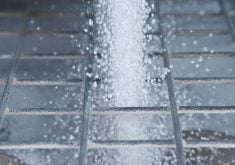Farmers look at many costs when they make a crop plan. One of the things I hear from a lot of growers is that certified seed doesn’t pay year after year.
Moving from Manitoba to Alberta in 1997, I wondered why there were not more seed growers in my new home province? And where did the farmers get their seed?
Most growers in central Alberta use bin-run cereals as their seed source, which means much of the seed is one year off of being certified.
Read Also

VIDEO: Tile drainage benefits may take longer than farmers think
Rick Rutherford of Rutherford Farms used tile drainage to help manage a saline area in his field at his Manitoba farm. Here’s what he learned.
However, not all of it gets planted every year. As well, seed reproduction as a part of a commercial crop doesn’t generally maintain the quality of the genetics.
One of the things that we in the agriculture industry must realize is that seven years of seed sitting in a bin doesn’t mean that it is still one year off of certified.
Kevin Dhuyvetter, an extension agricultural economist with Kansas State University, has studied the issue of saved seed. His work takes into account the value of certified over common seed, including the cost of cleaning, treatment and storage. The numbers in this column are based on his work and are a general guide. They can be adjusted to reflect a producer’s personal information.
A small increase in yield, say five percent, delivers an $8.04 per acre return in this model.
I’m not saying growers shouldn’t use their own seed. Rather, it is to point out the inaccurate perception that saved seed improves margins by cutting costs.
It is scientifically proven that the longer you go with the same seed, the lower the yield and the greater the levels of contamination, disease susceptibility and reduced protein levels.
Growers are often amazed when they compare a new variety to the old standby and wonder why they are getting a higher yield and protein.
Some credit can go to breeding improvements.
The industry has seen a 10 percent or more increase in yield over the past decade because of better genetics.
However, part of the benefit growers receive when they use certified seed comes from growing better quality seed, fewer generations away from the source.
New genetics often provide better disease or insect tolerance that benefits growers in certain years. It is the combination of traits and better quality seed that combine to create the yield enhancement.
I am not saying you have to change varieties every year, but I am saying there is a benefit to using certified seed every year.
For one thing, you have the opportunity to try something new more often. As well, just because a variety does well on paper doesn’t mean it is going to work on your farm. Even when you feel you have the right variety for your operation, regularly refreshing that seed pays off.
One of the reasons I have such a strong feeling about certified seed, beyond seeing the results on customers’ farms, is that I have witnessed first-hand the value of certified seed on our farm.
At a minimum, we have been breaking even on the seed cost.
Add to that the benefits of great genetics and quality seed will pay off, especially in challenging years when poor weather, disease or pests come to call.
Farmers often cut seed treatments when input costs increase. They are one of farmers’ most valuable tools when it comes to reduced tillage seeding because they help ward off soil and seed borne diseases and creates the foundation for a healthy plant.
Considering that we are finding evidence of a potential wireworm problem developing this fall, one might want to use a seed treatment that contains an insecticide. We were finding high populations, and if conditions are right for the insect, we could have a real outbreak next year.
There are lots of things we can do to get the crop off to a great start, but it all begins with the seed.














